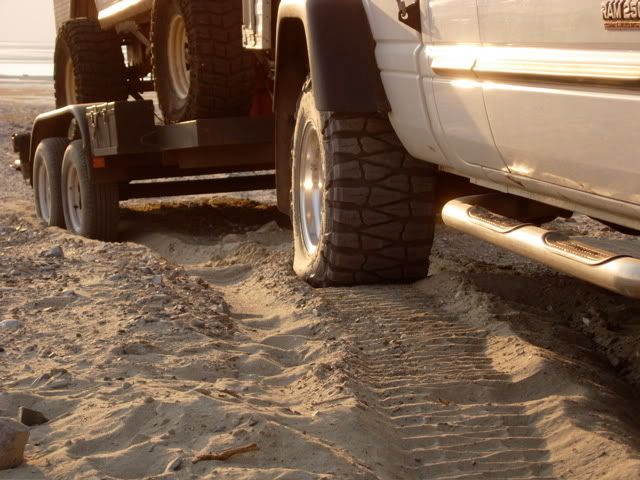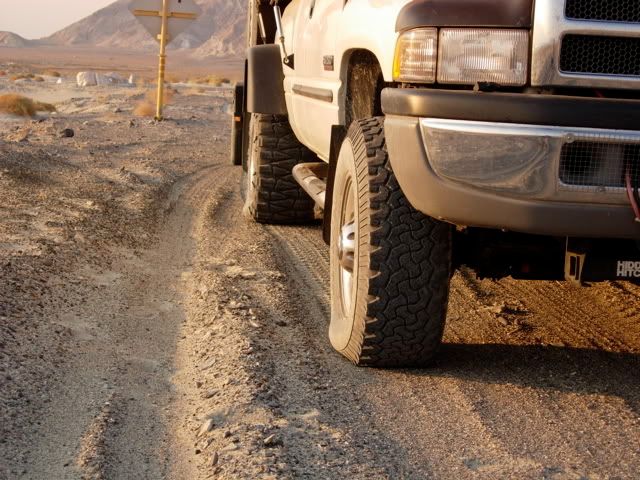- Good Sam Community
- Groups
- Travel Trailer Group
- Forum
- 2013 F350 DRW going to the beach- rear wheel space...
- Subscribe to RSS Feed
- Mark Topic as New
- Mark Topic as Read
- Float this Topic for Current User
- Bookmark
- Subscribe
- Mute
- Printer Friendly Page
2013 F350 DRW going to the beach- rear wheel spacers
- Mark as New
- Bookmark
- Subscribe
- Mute
- Subscribe to RSS Feed
- Permalink
- Report Inappropriate Content
Aug-30-2015 12:19 PM
If you are adding wheel spacers please tell me the thickness and any brand recommendations you have.
Do the spacers have any negative effects that will cause problems in general use?
Many thanks in advance for advice.
Joe
- Labels:
-
Truck Campers
- Mark as New
- Bookmark
- Subscribe
- Mute
- Subscribe to RSS Feed
- Permalink
- Report Inappropriate Content
Aug-31-2015 08:04 AM
I just got back from 88 days on the road- MA to OR, down the PCH and back again and before I left I put on 4 new tires and added the Crossfires. The result was a bad imbalance that shook the truck at 70 or so. It was bad. I took them off for the trip. I also took the truck back to the garage to have them check the balance and it was off. Before I could reassemble everything it was time to leave for OR so I did my trip without them.
- Mark as New
- Bookmark
- Subscribe
- Mute
- Subscribe to RSS Feed
- Permalink
- Report Inappropriate Content
Aug-31-2015 07:47 AM
They have sophisticated prevention system that slows air flow, so even they might make convenience inflating, they can be pain in deflating.
Lately I saw the option on Crossfire that beside main valve on the system had additional valves on each hose fore speedy deflating.

- Mark as New
- Bookmark
- Subscribe
- Mute
- Subscribe to RSS Feed
- Permalink
- Report Inappropriate Content
Aug-31-2015 07:13 AM
If you come down this way let me know. I see plenty of duallys out on Assateague.
2008 Lance 1191 - 220w of solar - Bring on the sun!
- Mark as New
- Bookmark
- Subscribe
- Mute
- Subscribe to RSS Feed
- Permalink
- Report Inappropriate Content
Aug-30-2015 06:25 PM
- Mark as New
- Bookmark
- Subscribe
- Mute
- Subscribe to RSS Feed
- Permalink
- Report Inappropriate Content
Aug-30-2015 04:10 PM
Lowering the pressure is having spreading the load on bigger surface in mind, so the wheels will not "cut in" the sand.
Commonly dualies have much lower per tire load to start, so they are in big advantage even at full pressure.
It is personal choice, but I like a challenge and would not go that drastically down (my tires are at 80psi) .
You can always deflate the tires if you start spinning.

- Mark as New
- Bookmark
- Subscribe
- Mute
- Subscribe to RSS Feed
- Permalink
- Report Inappropriate Content
Aug-30-2015 03:18 PM
I'll just add that on other threads, posters with experience have noted that airing down the duals, even should they rub, will not hurt them at the low speeds generally seen on beach driving.
And of course, as already mentioned, air back up immediately upon going back to paved roads.
2014 Ram 3500 w/ Cummins/Aisin
2019 Northern Lite 10-2 EX CD LE Wet Bath
RV'ing since 1991
I took the road less traveled .....Now I'm Lost!
- Mark as New
- Bookmark
- Subscribe
- Mute
- Subscribe to RSS Feed
- Permalink
- Report Inappropriate Content
Aug-30-2015 03:04 PM
'02 GMC DRW D/A flatbed
- Mark as New
- Bookmark
- Subscribe
- Mute
- Subscribe to RSS Feed
- Permalink
- Report Inappropriate Content
Aug-30-2015 02:00 PM

Here back on terra firma fronts @ 22 pounds, rears @ 20 pounds.

Don't even ask how this happened. Just know that I quickly pumped the tires back up using my 20 pound CO2 tank.
jefe
- Mark as New
- Bookmark
- Subscribe
- Mute
- Subscribe to RSS Feed
- Permalink
- Report Inappropriate Content
Aug-30-2015 01:45 PM
My 3 target locations are Scusset Beach in Plymouth, Sandy Neck and out P-Town way. Plenty of truck campers go to all the places I mentioned. Hopefully some folks who have experience in those places will enlighten my.
Assateague is another possibility.
- Mark as New
- Bookmark
- Subscribe
- Mute
- Subscribe to RSS Feed
- Permalink
- Report Inappropriate Content
Aug-30-2015 01:35 PM
Host Mammoth 11.5 on Ram 5500 HD
- Mark as New
- Bookmark
- Subscribe
- Mute
- Subscribe to RSS Feed
- Permalink
- Report Inappropriate Content
Aug-30-2015 01:19 PM
- Mark as New
- Bookmark
- Subscribe
- Mute
- Subscribe to RSS Feed
- Permalink
- Report Inappropriate Content
Aug-30-2015 12:51 PM
No air pressure change or spacers will really increase the total surface area of the contact patch by very much at all.
In other words, if the sand is firm enough to support the weight on the tires that you have you shouldn't need to do anything. If it is not firm enough, you should stay OFF OF IT. Having an RV towed out of sand should it get stuck can be an expensive (and sometimes dangerous) undertaking.
For instance, if you are thinking about driving down a section of beach where there is no evidence of large vehicles having been there before......I suggest that you re-think your plans. There probably is a good reason that they haven't been there before......in addition to it possibly being illegal.





